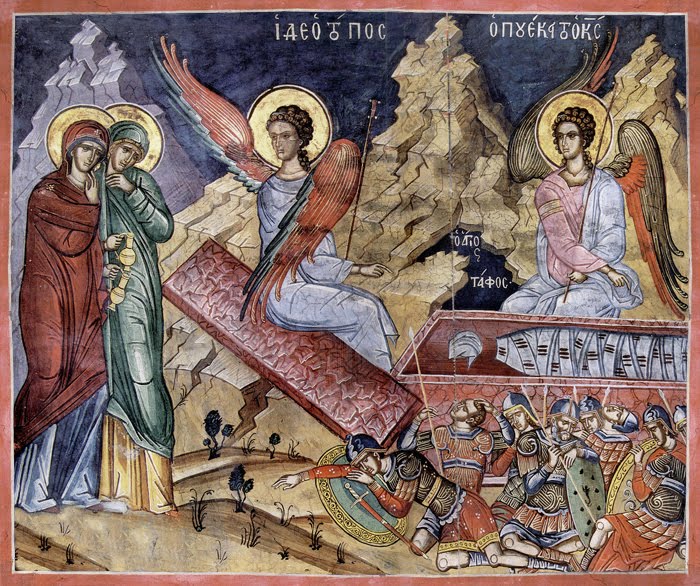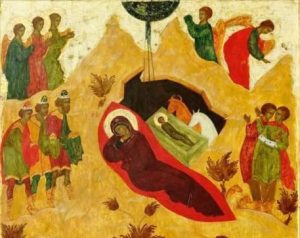Paschal Encyclical of 2021 Diocese of Pallini and Western Europe

“Our soul hath been delivered as a sparrow out of the snare of the fowlers.
The snare is broken, and we are delivered.” (Psalm 123:7)
Beloved in Christ,
When the gates of Paradise were shut by the sin of the first-created, the gate of sin was opened and death, the curse, and corruption entered the world through this gate.
St. Athanasius the Great explains to us that the snare or kingdom of death will show itself to be unfair from the very beginning. Adam and Eve will be the first to sin, but the first to die will be Abel their innocent son who was murdered by his brother Cain. This was to show what a wicked, unjust, and lawless tyranny the snare of death would be.
Now with the Holy Resurrection of Christ, this snare of death is broken. Broken for those to whom the Resurrection has been revealed. The Resurrection was both a salvific event made known to all believers and yet incomprehensible to those who did not and do not seek it.
Although we all await an ineluctable earthly death as an end to our vices, we, who believe in Christ and have the Resurrection as our engagement promise and a release from the snare, await also the endless life of the Resurrection. As the Apostle Paul tells us, “If Christ is not raised, then our preaching is inane, inane also is your faith” (1 Corinthians 15:14).
There were and are and will be those who refuse to see the Resurrection. The soldiers guarding the tomb in that very garden did not see the Resurrection of Christ. The tomb was still sealed and the angel rolled away the stone not for the soldiers who refused to accept this salvation, but for the Myrrhbearing women (Matthew 28:2). The soldiers who were not seeking salvation in Christ would see neither the Resurrection (even if they stood at the very place of the Resurrection) nor the Resurrected Christ!
The angel speaks to the women and says “Fear ye not” (Matthew 28:5). The “ye” stressing that these women should not fear because the angel knows that they “are seeking the crucified Jesus”. The angel, however, ignores the soldiers who had become like dead men from their fear. To the women does the angel say, “Come see the place”.
Fear and becoming like dead men belongs to those who are not seeking the crucified and risen from the dead Christ. Boldness belongs to those who “bow their heads to the ground” (Luke 24:5) venerating in piety. To those who bow to the ground, the question “Why do you seek the living among the dead?” is posed. But the guards of worldly powers are totally ignored by the angels and no such great mystery is personally communicated to them.
The Resurrected Christ reveals Himself to those who desire His presence. On the road towards Emmaus, Christ appears as if He wants to keep traveling onwards and only enters the house with Cleopas and Luke after they invite Him to stay with them (Luke 24:29). Only when we desire the presence of the Resurrected Christ does He enter our hearts even if “the doors be closed” by our own weaknesses and sins.
We will have sought the Resurrected Christ when He is the only thing in our mind and heart. When St. Mary Magdalene encounters Christ after the Resurrection she believes Him to be the gardener at first. When Christ asks her, “Who do you seek?”, she doesn’t answer by saying the name of the one she seeks but only answers “if you have kept Him, tell me and I will lift Him” (John 20:15). She doesn’t offer a name in answer to the question “Who do you seek?” because the only one in her heart and mind is Christ. Likewise, she believes she has the strength to lift Christ’s body because more than anything she desires her Master.
St. John the Evangelist begins his gospel with the words, “In the beginning was the Word” and when a word (her name, Mary) is spoken to Mary Magdalene, she recognizes the Word that she sought (John 20:16). Here it is clear that not everyone will recognize the Word but only those who have it in their heart to find Him. Only those sheep who know His voice. Those “sheep listen to His voice. He calls his own sheep by name and leads them out.” (John 10:3).
The very Source of immortality enters a tomb. A tomb is a place of corruption but Christ comes out of it as out of a bridal chamber. St. John of Damascus describes this when he writes, “Lifegiving and more beautiful than Paradise and brighter than any royal bridal chamber, your tomb is shown to be, O Christ, the source of our resurrection.” (Paschal hours).
But if He exits as from a bridal chamber, He offers himself to His bride which is His holy Church. The Bridegroom is sharing His life only with His Bride. Thus the revelation of the Holy Resurrection is bequested to the Church of Christ and we Her faithful cry out, “Having beheld the Resurrection of Christ, let us worship the Holy Lord Jesus, the only Sinless One!”
Greeting you all joyfully with the triumphant exclamation “Christ is risen!”,
+ Philaretos, Bishop of Pallini and Western Europe



